Unleashing Potential: The Future of Application Development
The realm of application development is experiencing unprecedented changes, propelled by technological advancements and evolving user expectations. As we move forward, understanding these changes is essential for businesses looking to thrive in an increasingly competitive landscape. The future of application development is characterized by several transformative trends that promise to reshape how applications are created, deployed, and used.
Embrace of Artificial Intelligence and Machine Learning:
Artificial Intelligence (AI) and Machine Learning (ML) are revolutionizing the application development landscape by introducing new levels of automation, personalization, and intelligence. AI-driven algorithms are enabling applications to learn from user behavior, predict needs, and offer tailored experiences.








Leave a Reply